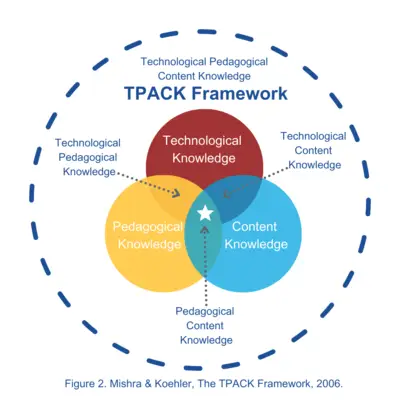Benefits of Blended Learning
In what looks like a traditional elementary school classroom, Marisol, a 3rd grade student, sits at a small table with a group of five students at the Teacher-Led Station. The teacher has selected this group based on the students’ needs for additional support in mastering fractions, recently covered in their core mathematics curriculum. Students in the previous Teacher-Led Station rotation group had already demonstrated mastery of fractions, so the teacher provided differentiated instruction with a recipe conversion activity that gave the students the opportunity to try more advanced mathematics concepts.
They now sit together in the Individual Station, working independently on their laptops, using a “playlist” lesson the teacher posted on Canvas that enables each student to choose different instructional materials needed to learn more about the topic they are studying next. Another group of students is sitting together in the Collaboration Station, working with a partner, and taking turns at solving problems independently and checking each other’s work using the Solve-Then-Switch protocol their teacher taught them earlier in the year. All students in the class rotate through the three stations during the 60-minute math block.
At the beginning of the school year, the teacher implemented this blended learning instructional approach as the best way to address the vast differences in her students’ abilities.
Education Transformed by Technology
With the onset of the COVID-19 pandemic, teachers found themselves transformed into virtual instructors overnight. Educators across the globe morphed into tech experts in an attempt to ensure that learning continued for students. Tens of thousands of teachers flocked to social media, especially the Facebook groups “Teachers Using Canvas” and “HyperDocs,” as an extended professional learning community focused on sharing tips and tricks. Canvas usage increased by 60% in just the first 2 weeks of the pandemic.
Teachers’ transition to virtual instruction occurred out of necessity. Most teachers, however, had acquired most of their teaching experience in a brick-and-mortar school setting. In fall of 2021, most educators returned to face-to-face classroom instruction. One benefit of the pandemic was that almost all school districts had the devices to support 1-to-1 technology integration. Many school and district leaders assumed that teachers, many with newfound technology expertise, would easily transition into a blended learning style of instruction, but this was not the case.
Innovative Instruction
Blended learning is an educational approach that leverages the strengths of face-to-face teaching and online learning. One commonly used approach to blended learning was co-authored by Heather Staker and Michael Horn. According to this model, blended learning classrooms can be structured into four models: Rotation, Flex, A La Carte, or Enriched Virtual. In the Rotation Model, students move between different learning modalities, one of which is an online setting. Four different methods can be used for the Rotation Model:
- In the Station Rotation method, students rotate between set stations on a structured schedule. One of the stations must take place online. Station Rotation can also take place in one classroom or multiple classrooms.
- The Lab Rotation method is similar to Station Rotation, except the online learning component takes place in a computer lab.
- In the Flipped Classroom method, students learn the content away from the classroom and use class time for guided practice, collaborative work, or projects.
- In the Individual Rotation method, students rotate to stations, dependent on their unique needs. Using this model, the teacher may direct students' placement at stations, or the student may use a playlist to inform their station selection.
All models for blended learning share the common foundational understanding that digital teaching and learning require the engagement of both teacher and student, with technology integrated to enhance student control over time, place, path, and pace. The most important element, however, is still the connection between effective instruction and student learning. Effective blended learning is founded on a solid understanding of the integration of content knowledge, pedagogy, and technology.
Technology As a Tool for Effective Instruction
Simply using technology is not the end goal, but rather the means to an effective blend of instructional practices. Effective blended learning instruction depends on a solid understanding of how to combine the content and teaching approach with technology use. The Technological, Pedagogical, Content Knowledge (TPACK) framework, introduced by Punya Mishra and Matthew J. Koehler in 2006, recognizes the connection between teaching, technology integration, and student learning and acknowledges that, for effective student learning to take place, the content (what you teach) and the pedagogy (how you teach) must match the technological task selection.
 The TPACK framework is an essential component of any blended learning classroom, as effective learning requires the integrated application of teacher knowledge. As blended learning seeks to engage students and meet diverse student needs, successful instructional planning must include the intentional application of the TPACK framework. A system for supporting the development of TPACK knowledge as a part of planning for effective blended learning instruction will also ensure long-term sustainability of the instructional approach.
The TPACK framework is an essential component of any blended learning classroom, as effective learning requires the integrated application of teacher knowledge. As blended learning seeks to engage students and meet diverse student needs, successful instructional planning must include the intentional application of the TPACK framework. A system for supporting the development of TPACK knowledge as a part of planning for effective blended learning instruction will also ensure long-term sustainability of the instructional approach.
Professional learning introduces teachers to the information, and instructional coaching provides support for teachers on planning and implementing engaging blended learning lessons.
Increased Success at School
Blended learning also requires a comprehensive approach that addresses the varying needs and abilities of all staff members. RTI’s Blended Learning Rubric helps teachers to identify their strengths and areas for growth in four fundamental areas: personalized learning, technology use, 21st century skills, and classroom arrangement. The rubric serves as an anchor for all staff members as it clearly defines the components of blended learning instruction but provides multiple entry points based on each individual’s previous experiences and knowledge. The tool can be used by coaches to guide the cadence of an instructional coaching cycle or by an administrator to give specific feedback after a formal classroom observation.
For a focus on the application of a particular blended learning model, model-specific tools combine the foundational components of blended learning with guidance that is specific to each model. These rubrics, administrator walkthrough tools, coaching questions, family guides, and a plethora of helpful resources can be found in RTI’s Blended Learning Toolkit: Leveraging the Strengths of Face-to-Face and Online Learning.
Blended Learning: Rethinking Instruction
The COVID-19 pandemic presented tremendous instructional challenges for teachers and schools. The increase of technology awareness and skills presents the possibility of approaching pedagogy in a way that increases the opportunities to differentiate instruction, student engagement, and motivation.
Blended learning is an opportunity to rethink the approach to instruction; with thoughtful planning and intentional implementation, one of the most trying times for education can transform teaching practices in a way that better meets the needs of all learners while preparing students for future success.


